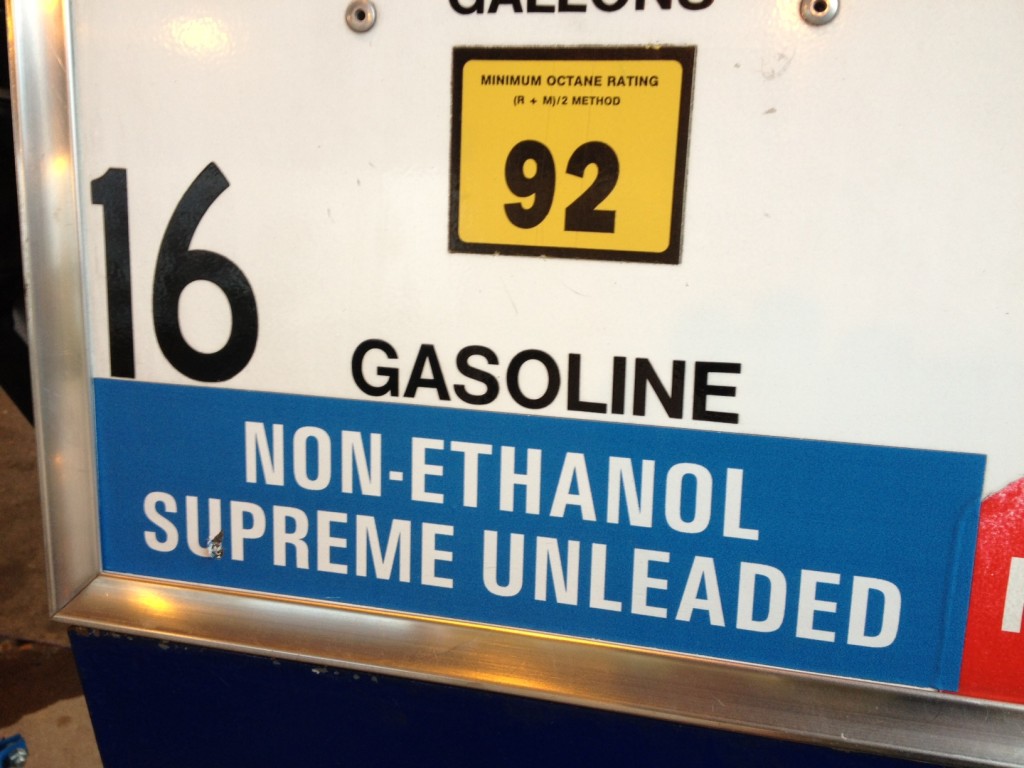Over the past decade, the vast majority of U.S. pump gasoline has transitioned to 10% ethanol—or even, depending on where you are, 15% ethanol.
The EPA tests that bring us official fuel economy numbers are just in the process of catching up with that reality. Tier 3 tests run on E10 aren't mandated until model year 2021. Until 2017, all were Tier 2 tests, run on the now-rare fuel called Indolene in official protocol but better known simply as non-ethanol gasoline, "neat" gasoline, or E0 for its lack of added ethanol.

Non-ethanol gasoline pump
Which leads to a sticky point: Adding ethanol to gasoline drops the energy content and the gas mileage, while decreasing the carbon dioxide emitted per gallon. But if you start the carbon calculations with the fuel in the fuel tank and ignore the other debatable pieces regarding growing, producing, and transporting the fuels, it’s a net negative of up to a few percent in “carbon-balance fuel economy,” as policymakers call it.
Automakers, of course, understand that within the maze of adjustment factors for emissions and fuel economy numbers, that’s a negative that could bring down their corporate average fuel economy (CAFE) numbers—and those on the window sticker.
So they’re asking the EPA to kindly not adjust for the new fuel—the one that Americans use.
In a National Register filing published Wednesday, the EPA stated the issue clearly: “As discussed in Section III, EPA estimates that the impact on CO2 emissions is a 1.6% difference, and thus without the test procedure adjustment proposed in this notice, a change from the Tier 2 gasoline certification fuel to the Tier 3 gasoline certification fuel would reduce the stringency of the EPA CO2 standards by 1.6%.”

E10 vs. E0 - carbon-balance fuel economy compared
The agency “requests comment on whether the Agency should consider a regulatory approach where we require the use of Tier 3 gasoline certification fuel without any test procedure adjustment for CO2. If the Agency were to consider such an approach, EPA also requests comment as to whether EPA would need to complete additional analysis.”
The last testimony for the cause from automakers, by the Alliance of Automobile Manufacturers, was in January before the Final Rule for U.S. vehicle emissions and fuel economy requirements was issued in late March. That rule relaxed the level of required fleetwide improvement from its previous 5% per year to just 1.5%.
Union of Concerned Scientists analyst Dave Cooke, who wrote about the seemingly covert operation Wednesday on the group’s clean-energy-focused policy blog, called the move “brazen.”
Because of the way the fuel requirements have already been phased in, automakers are essentially requesting a 1.6% break on fuel economy moving forward.
The original EPA rule from 2014 is something automakers have already been contending with—albeit in a graduated fashion. It phased in so-called Tier 3 standards incrementally, starting with 20 percent of the light-vehicle fleet for the 2017 model year up to 100 percent for the 2021 and later model years.
That rule specified the need for “some adjustment provided for in-use testing in the early model years of the program.”
![Fuel economy and emissions progress by manufacturer, 2013-2018 [U.S. EPA] Fuel economy and emissions progress by manufacturer, 2013-2018 [U.S. EPA]](https://images.hgmsites.net/lrg/fuel-economy-and-emissions-progress-by-manufacturer-2013-2018-u-s-epa_100740481_l.jpg)
Fuel economy and emissions progress by manufacturer, 2013-2018 [U.S. EPA]
If such an adjustment isn’t made, it might make efficiency ratings even more detached from reality and, potentially, undo part of the very modest tightening the Trump Administration agreed to above its original freeze.
Green Car Reports has reached out to the Alliance to try to understand whether their position remains the same after the relaxed standards, and this piece will be updated to reflect an official response.
